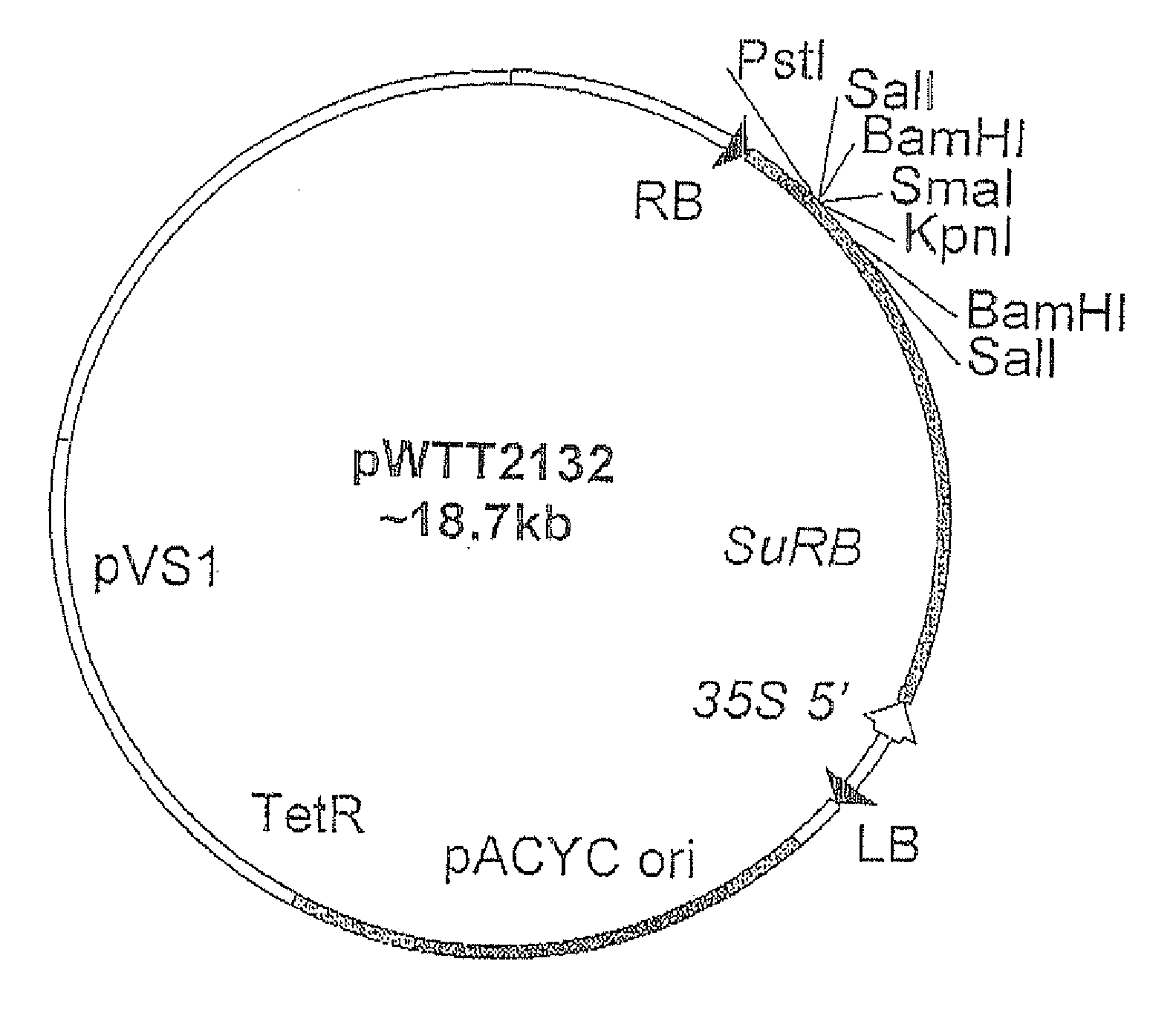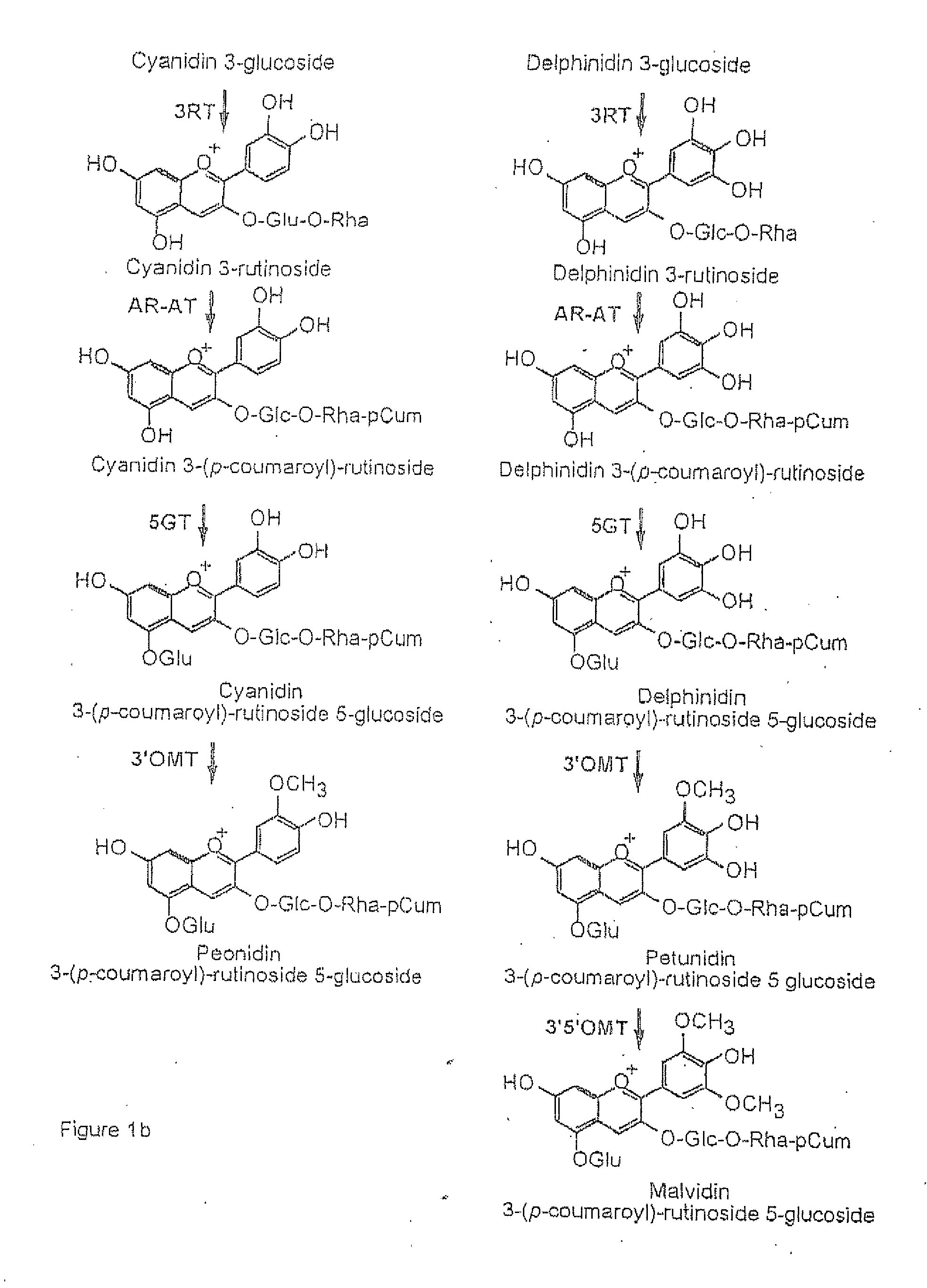Flavonoid 3',5' hydroxylase gene sequences and uses therefor
a technology of flavonoid and hydroxylase, which is applied in the field of gene sequences encoding polypeptides having flavonoid 3′, 5′hydroxylase, can solve the problems of limited application and achieve the effect of efficient conversion of dhx
- Summary
- Abstract
- Description
- Claims
- Application Information
AI Technical Summary
Benefits of technology
Problems solved by technology
Method used
Image
Examples
example 1
General Methods
[0163]In general, the methods followed were as described in Sambrook et al. (1989, supra) or Sambrook and Russell, Molecular Cloning: A Laboratory Manual 3rd edition, Cold Spring Harbor Laboratories, Cold Spring Harbor, N.Y., USA, 2001 or Plant Molecular Biology Manual (2nd edition), Gelvin and Schilperoot (eds), Kluwer Academic Publisher, The Netherlands, 1994 or Plant Molecular Biology Labfax, Croy (ed), Bios scientific Publishers, Oxford, UK, 1993.
[0164]The cloning vectors pBluescript and PCR script were obtained from Stratagene, USA. pCR7 2.1 was obtained from Invitrogen, USA.
E. coli Transformation
[0165]The Escherichia coli strains used were:
DH5α
[0166]supE44, Δ (lacZYA-ArgF)U169, (ø80lacZΔM15), hsdR17(rk−, mk+),
recA1, endA1, gyrA96, thi-1, recA1, deoR. (Hanahan, J. Mol. Biol. 166: 557, 1983)
XL1-Blue
[0167]supE44, hsdR17(rk−, mk+), recA1, endA1, gyrA96, thi-1, recA1, lac−, [F′proAB, laclq, lacZΔM15, Tn10 (tetR)] (Bullock et al., Biotechniques 5: 376, 1987).
BL21-Codo...
example 2
Plane Transformations
[0183]Petunia hybrida Transformations (Sw63 x Skr4)
[0184]As described in Holton et al. (1993a, supra) by any other method well known in the art.
Rosa hybrida transformations
[0185]As described in U.S. Pat. No. 542,841 (PCT / US91 / 04412) or Robinson and Firoozabady (Scientia Horticulturae, 55: 83-99, 1993), Rout et al. (Scientia Horticulturae, 81: 201-238, 1999) or Marchant et al. (Molecular Breeding 4: 187-194, 1998) or by any other method well known in the art.
[0186]Cuttings of Rosa hybrida were generally obtained from Van Wyk and Son Flower Supply, Victoria.
Dianthus caryophyllus Transformations
[0187]International Patent Application No. PCT / US92 / 02612 (carnation transformation). As described in International Patent Application No. PCT / AU96 / 00296 (Violet carnation), Lu et al. (Bio / Technology 9: 864-868, 1991), Robinson and Firoozabady (1993, supra) or by any other method well known in the art.
[0188]Cuttings of Dianthus caryophyllus cv. Kortina Chanel or Monte Lisa w...
example 3
Transgenic Analysis
[0189]The Royal Horticultural Society's Color Chart (Kew, UK) was used to provide a description of observed color. They provide an alternative means by which to describe the color phenotypes observed. The designated numbers, however, should be taken only as a guide to the perceived colors and should not be regarded as limiting the possible colors which may be obtained.
Chromatographic Analysis
[0190]Thin Layer Chromatography (TLC) and High performance Liquid Chromatography (HPLC) analysis was performed generally as described in Brugliera et al. (Plant J. 5, 81-92, 1994).
Extraction of Anthocyanidins
[0191]Prior to HPLC analysis, the anthocyanin and flavonol molecules present in petal and stamen extracts were acid hydrolysed to remove glycosyl moieties from the anthocyanidin or flavonol core. Anthocyanidin and flavonol standards were used to help identify the compounds present in the floral extracts.
[0192]Anthocyanidins in the reaction mixture were analysed...
PUM
 Login to View More
Login to View More Abstract
Description
Claims
Application Information
 Login to View More
Login to View More - R&D
- Intellectual Property
- Life Sciences
- Materials
- Tech Scout
- Unparalleled Data Quality
- Higher Quality Content
- 60% Fewer Hallucinations
Browse by: Latest US Patents, China's latest patents, Technical Efficacy Thesaurus, Application Domain, Technology Topic, Popular Technical Reports.
© 2025 PatSnap. All rights reserved.Legal|Privacy policy|Modern Slavery Act Transparency Statement|Sitemap|About US| Contact US: help@patsnap.com



